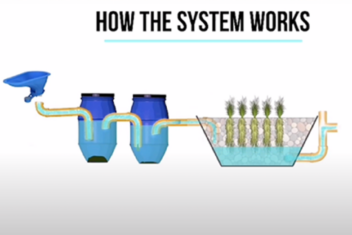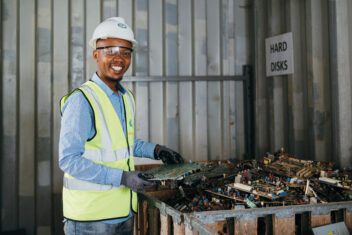Sustainability & partnerships: Abhijit Banerji (FINISH Society) interview

Diving back in history
WASTE and its partners around the world have been changing the development game for nearly 4 decades. We have together developed sustainable and inclusive solutions to many challenges in the waste management and sanitation sectors. Approaching the organisation’s 40th anniversary, we wanted to revisit some key players from our history of collaborations to learn lessons on how we can maintain the spirit of our founders and early work as we move forward.
The following traces WASTE’s history through three continents and many decades, sharing the stories of 7 pivotal individuals who have contributed to this spirit through our work together. These individuals and organisations have continued to share our spirit of inclusivity in everything they do.
A few key takeaways
- Through our holistic approaches, WASTE and its partners around the world have been working on the underlying concepts of ‘circularity’ for decades. It is only recently that high level discussions have rebranded and called more attention to the importance of what is called today “circular economy”. Circularity is integrated in our approach.
- Working with the informal sector is difficult but a critical component to sustainable waste management systems. All our partners echo that this aspect of the work as pivotal to the inclusion and innovative nature of their work.
- Institutionalisation of key concepts and approaches in policy, whether on local or national scales, are crucial for ensuring sustainability of our work.
- Buy-in from the communities, especially local leaders, can either catalyse the success of or be the sole reason for failure of interventions. We must ensure our programmes and solutions are co-created with and by the communities we are trying to serve.
- Real change and local ownership take time to have sustained impact. Our projects, ambitions, and relationships with key stakeholders, shouldn’t forget this key consideration.
Gamechanger 6: Abhijit Banerji
Managing Director, FINISH (Financial Inclusion Improves Sanitation & Health) Society
Lucknow, India
“We have had so much of freedom in designing and implementing the programme, and I always believe very strongly that the reason behind the success of this program has been the flexibility and trust that we have had and enjoyed with WASTE.“
1. How long have you been working in sanitation and waste management?
Through our partnership, we have built our technical capacity and our approach of how the sanitation market can be serviced. It is from there that we evolved into other segments such as school WASH, waste management, household sanitation, etc. The core approach applied is the same as that of WASTE NL. The model we follow is an ‘eco-system’ approach. We try to keep operating costs low, leveraging funding and resources from other players.
We began the first waste management programme in 2014. We started with the municipality of Udaipur, by helping them improve the sanitation situation. They liked the commitment of our team and how the team was delivering on the sanitation portfolio. We were further discussing the waste management issues of the city together. With the high level of commitment of the team, our work further translated into multiple projects with different municipalities around India (i.e. Udaipur, Dungarpur (Rajasthan), Gaya, and others in the states of Andhra Pradesh, Orissa and Bihar). That is how we gradually got into this and other relevant sectors that we are working on.
2. What is the thematic focus of FINISH Society?
Ever since India was declared open defecation free (ODF), there has been a lack of support and grants for nonprofits working on sanitation. Given this business environment, we expanded our portfolio to include waste management as well. At present, we are particularly focused on wastewater treatment because very little grey water is treated in India, making it an area of high importance for the future. Also, the Government of India is focusing on the Jal Jeevan mission. This focuses on providing access to drinking water and given the scarcity of such, wastewater treatment will become an important tool towards achieving these national development goals as well.
We also did two wastewater treatment projects for the municipality in Dungarpur earlier. We are currently focused on a similar one for The Nature Conservancy in Chennai, where we have designed a large plant for TNC. The idea is to treat about 7 million liters of water every day with an aim to make the water of the Sembakkam Lake usable soon. Interestingly, the technology that we are using for this project is focused on planned constructed wetlands, something that we picked up from WASTE. We use this, combined with a mix of other technologies, making this model both low maintenance and low on capital and operating expenditures.
Our current idea is to develop a vertical for nature-based solutions (NBS) while gradually building our own capacities and understanding of the market. The other vertical is on skill training and livelihoods, looking at the adverse effects of COVID-19, especially in terms of employment and economic development.
3. How do you see scalability in your projects? Is it only geographic or are quality and sustainability also key considerations?
Quality is paramount. Ever since we began, the unique selling point (USP) of our sanitation programme has been the safely managed aspect of sanitation. We continue to strive for that. A similar focus is there for other projects, and I suppose that is the reason why clients that have worked with us in the past continue to work, support, and expand with us. The quality focus is essential, something which the Government of India also recognized, making us a Key Resource Training Centre (KRC) for the purpose of sanitation. With quality, we also try to attain scale, as a certain amount is required to reach economies of scale. This is key since our ambition is to keep facilitation costs low and create bigger impact.
4. Could describe your process of our collaborations?
The best part about FINISH Society’s partnership and relationship with WASTE has been how we work together. We have had so much of freedom in designing and implementing the programme, and I always believe very strongly that the reason behind the success of this program has been the flexibility and trust that we have had and enjoyed with WASTE. At the same time, whenever there was a need of assistance and support in terms of capacity building, discussions, working out solutions, or looking for new partnerships, we have always had excellent support.
I believe we have taken up an approach like that of WASTE in the work and also as an organisation. There is a lot of focus on trust between the team members and partners. Today, we are glad that most of the people who joined the organisation have stayed with us, with most being associated with us for at least four or more years. This is great considering that we only became fully functional in 2012. Thus, we have all stuck along and grown, and done well together, making it a good ride so far. In the Indian NGO sector is particularly unique, given the case of high potential people who have received other offers. While some people have of course left to join much bigger brands and companies, but there are many who have preferred to stay. The team is happy and proud to work with the cause and the organisation.
5. What are some alternative approaches to WASTE’s Diamond model that you have adopted?
While the bedrock is the Diamond or the ecosystem approach where we try to integrate everything, a lot also depends on the ground realities and situations. This dictates how the model can be customized. Thus, a lot of freedom is also given to the team on the ground to decide what works best there. Just like WASTE has supported us, we also try and support the teams on the ground in a similar manner by giving them the freedom to see what will work best in their area, while providing them with backend support.
6. What are some of the challenges that you face with this work?
One of the challenges includes the operational issues which a small organization like ours encounters. There is always a challenge of managing a large programme spread across different states, while at the same time, managing the human infrastructure behind it. For example, our teams are today spread across 12 states. Managing these teams and providing them with support can be quite challenging at times. Further, one of the biggest challenges for us while expanding the projects is getting a good quality manpower, especially since we have this dichotomy—our pockets are limited but we are looking for quality manpower, making it a difficult balancing act.
7. What do you see for the future of this work?
I see a lot of opportunities together, one of which is the possibility of working on health infrastructure. For me it is the model of how we can leverage commercial financing and support that with grant for a social good. This model can be used in many ways, such as for improving drinking water, on municipalities or waste management enterprises and infrastructures. India is a huge market, and we have been able to build a team and culture which should last and deliver results.


